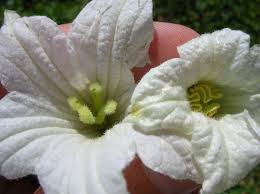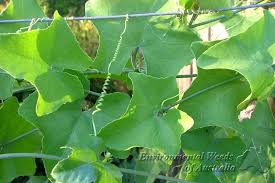http://www.sidhhaherbs.blogspot.com
Ivy gourd occurs wild in northern and eastern Africa, Arabia to tropical south and southeast Asia. It has spread and become naturalised in Tropical northern Australia and Fiji and occasionally adventive in the neotropics
“Coccinia Grandis”-
கோவைக்காய்
தெரியுமா? அல்லது அதன்
பயன் தான் தெரியுமா?
This green vine is grown widely through out Malaysia.


Kovai has the property towards reducing one's glucose level.
 The gourd is considered as vegetable and appreciated for its unique taste. Widely used in culinary. Gourd has the property towards reducing one's glucose level. Researchers are now showing interest in common plants, which have more pharmacological uses than one could imagine. The gourd is said to have the properties to lower one's glucose level. To be more specific...it suppress the activity of enzymes that are involved in the production of glucose, such as G-6-phosphatase. Although the leaves tend to have more properties than the gourd itself. Maybe the foliaceous nature of this creeper...gets very little attention! Wish Ethonobotonist give some holistic approach towards the whole plant/vine.
The gourd is considered as vegetable and appreciated for its unique taste. Widely used in culinary. Gourd has the property towards reducing one's glucose level. Researchers are now showing interest in common plants, which have more pharmacological uses than one could imagine. The gourd is said to have the properties to lower one's glucose level. To be more specific...it suppress the activity of enzymes that are involved in the production of glucose, such as G-6-phosphatase. Although the leaves tend to have more properties than the gourd itself. Maybe the foliaceous nature of this creeper...gets very little attention! Wish Ethonobotonist give some holistic approach towards the whole plant/vine.
Scientific Name- “Coccinia Grandis”
Ivy Gourd, Gentleman’s Toes (English)
Dondakaya, Dondakai (Telugu)
Tondakayi (Kannada)
Vargoli (Hindi)
Tindora, Ghiloda (Gujarati)
Tondli, Tendli (Marathi)
Kovakkai (Malayalam)
Kovaikai (Tamil)
Kundru (Utter Pradesh)
Medical Research suggests that gherkins may suppress the activity of certain enzymes involved in glucose production, such as G-6-phosphatase and helps control diabetes.
Coccinia grandis, the ivy gourd, also known as baby watermelon, little gourd, gentleman's toes, tindora or gherkin is a tropical vine. It is also known as Cephalandra indica and Coccinia indica. Wikipedia
கோவை (கொவ்வை, Coccinia cordifolia) மருத்துவப் பயன்பாடுடைய தாவரமாகும்.
இக் கொடித் தாவரம் பற்றைக் காடுகள், வேலிகளில் வளர்கிறது. இதன் இலையின் பிளவு அமைப்பைக் கொண்டு மூவிரல் கோவை, ஐவிரல் கோவை என்ற பிரிவுகள் உண்டு. இதன் பூ வெள்ளை நிறமானதாகும். இலை, காய், தண்டு, வேர் என எல்லாப் பாகங்களும் மருத்துவ குணமுடையனவாகும். இலைக்கஞ்சியில் இதன் இலை சேர்க்கப்படுவதுண்டு.
கண்குளிர்ச்சியை உண்டாக்கும். இலைச்சாற்றுடன் வெண்ணெய் சேர்த்து சிரங்குகளுக்குப் பூசலாம். இதன் இலைச்சாற்றைப் பருகி வந்தால் நீரழிவு நோய் கட்டுப்படும். கொவ்வங்காய் கோரோசனை மாத்திரை செய்யப் பயன்படுகிறது.
Ivy gourd occurs wild in northern and eastern Africa, Arabia to tropical south and southeast Asia. It has spread and become naturalised in Tropical northern Australia and Fiji and occasionally adventive in the neotropics
“Coccinia Grandis”-
கோவைக்காய்
தெரியுமா? அல்லது அதன்
பயன் தான் தெரியுமா?
Indian Ivy Gourd is a widely consumed vegetable, available in India and Malaysia through out the year. Called Kovai keerai and Kovai Kai in Tamil and Dondakaya (Telugu) or Tindora/Tondli (Hindi), these cute looking small, stubby, green colored vegetables which grow aggressively on vines are used to prepare delicious stuffed curries, stews, pickles, salads and stir fries.
Ivy Gourd is considered as weed in many parts of the world . It comes under the Cucurbitaceae family(Family of Cucumbers). The Botanical name of the vine is Coccinia indica. Name indicates it is native to India. Although it grows all round the Asian countries. Also in West Indies and Hawaai. It is highly valued as food and medicine in Thailand! In India, the Ayurveda text, mentions about its usage in various ailments.
General characteristic of Vines with small green are round tendrils. The tendrils are 12-14 cm long, single and spring-like twisted, oppositely inserted to leaves. Leaves are simple and alternate. Leaves' bases are in heart-shaped, sharpened tip and curvy edge. The shape of the leaf is star-liked with 5 rays. 5-7 veins separated from leaves' bases. Leaves are 3-4 cm wide, 5-6 cm long. A stem is 3-5 cm long. Flowers are solitary, axillary, and sometimes fasciculate. Berry-like fruits are green when young and red when ripe. Inflorescence is during April-December. Fruiting during June-January. Propagating by seeds and preserved stems.
Kovai has the property towards reducing one's glucose level.
Scientific Name- “Coccinia Grandis”
Ivy Gourd, Gentleman’s Toes (English)
Dondakaya, Dondakai (Telugu)
கோவைப்பழம்போல்சிவந்தஇதழ்கேள்விப்பட்டுள்ளீர்களா?
Dondakaya or Tondli is a small oblong shaped, smooth skinned, light green to dark green shade, abundantly available Indian vegetable
Has a mild sour flavor with a crunchy juicy texture
Has medicinal value and used widely in Traditional Thai and Ayurvedic Medicine
Contains beta-carotene and a good source of protein and fiber
Has a mild sour flavor with a crunchy juicy texture
Has medicinal value and used widely in Traditional Thai and Ayurvedic Medicine
Contains beta-carotene and a good source of protein and fiber
Medical Research suggests that gherkins may suppress the activity of certain enzymes involved in glucose production, such as G-6-phosphatase and helps control diabetes.
Coccinia grandis, the ivy gourd, also known as baby watermelon, little gourd, gentleman's toes, tindora or gherkin is a tropical vine. It is also known as Cephalandra indica and Coccinia indica. Wikipedia
கோவை (கொவ்வை, Coccinia cordifolia) மருத்துவப் பயன்பாடுடைய தாவரமாகும்.
இக் கொடித் தாவரம் பற்றைக் காடுகள், வேலிகளில் வளர்கிறது. இதன் இலையின் பிளவு அமைப்பைக் கொண்டு மூவிரல் கோவை, ஐவிரல் கோவை என்ற பிரிவுகள் உண்டு. இதன் பூ வெள்ளை நிறமானதாகும். இலை, காய், தண்டு, வேர் என எல்லாப் பாகங்களும் மருத்துவ குணமுடையனவாகும். இலைக்கஞ்சியில் இதன் இலை சேர்க்கப்படுவதுண்டு.
கண்குளிர்ச்சியை உண்டாக்கும். இலைச்சாற்றுடன் வெண்ணெய் சேர்த்து சிரங்குகளுக்குப் பூசலாம். இதன் இலைச்சாற்றைப் பருகி வந்தால் நீரழிவு நோய் கட்டுப்படும். கொவ்வங்காய் கோரோசனை மாத்திரை செய்யப் பயன்படுகிறது.
இலக்கியத்தில் கோவை]
இதன் பழங்கள் ஒரு கவனிக்கத்தக்க செந்நிறத்தில் இருக்கும். இதன் காரணமாக திருநாவுக்கரசர்பின்வரும் தனது பாடலில் சிவனின் வாய்நிறத்திற்கு உவமையாக இதைப் பயன்படுத்துகிறார்.
குனித்த புருவமும் கொவ்வைச் செவ்வாயில் குமிண் சிரிப்பும் பனித்த சடையும் பவளம்போல் மேனியில் பால்வெண்ணீறும் இனித்தமுடைய எடுத்த பொற்பாதமும் காணப்பெற்ல் மனித்தப் பிறவியும் வேண்டுவதே இந்த மாநிலத்தே நன்றி: த.விக்கிபீடியா
physicianpackiamhttp://www.sidhhaherbs.blogspot.com
(69)
Comments